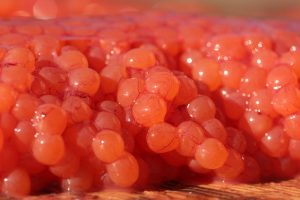 Salmon eggs could be the most effective and widely used natural bait in the world of river fishing for salmon and steelhead. With fall salmon season upon us, now is a good time to plan ahead in order to optimize the quality of eggs you’ll soon be attaining, as well as what you’ll be fishing with in weeks and months to come.
Salmon eggs could be the most effective and widely used natural bait in the world of river fishing for salmon and steelhead. With fall salmon season upon us, now is a good time to plan ahead in order to optimize the quality of eggs you’ll soon be attaining, as well as what you’ll be fishing with in weeks and months to come.
When curing salmon eggs, the process begins well before the eggs actually go into the curing jar. The curing process starts the moment a fish is landed. It’s crucial to take care of the eggs during transport, so as not to damage them.
To help promote fresh, high quality eggs, start with bleeding the fish as soon after the catch as possible. First, strike the fish on the head to ensure a quick, clean kill, then take what photos you need.
Once dead, there are a few ways to bleed a fish. Which ever option you choose, do it quickly before the blood sets up in the body cavity of the dead fish. Blood coagulates fast in dead fish, making it a bacterial breeding ground. This, in turn, creates foul odors which can pass to the cured egg and potentially repel salmon. Since salmon have a sense of smell measured in parts per billion, it’s important to pay attention to such details early on, well before the actual curing even takes place.

Most popular and easiest of all when it comes to bleeding a fish, is to cut a gill rake. This can be done by cutting it with a knife, snipping it with scissors or pliers,or busting it with your fingers. With several gill rakes on each side, under the gill plates, busting a couple at a time will result in faster bleeding.
Another bleeding option is taking a sharp knife and cutting on the underside of the tail, at the base. Be sure to cut all the way to the spine, so you’ll hit the main vein. This method allows you to hold the fish by the gills while it bleeds out, but does take longer than snapping a gill rake.
A third option is inserting a long knife into the underside of the upper belly, at the heart. Be sure the blade enters in front of the pectoral fins so as to avoid slicing the eggs. This is where most of the blood coagulates in a dead fish, and much of it congeals around the eggs. Bleeding a fish in this way allows you to grab it by the tail and hold it in the water to bleed out. It’s a fairly fast process.

Depending on where you’re at and the conditions you’re fishing in, you may want to transport your eggs inside the fish in order to prevent damaging the skeins. A bled body cavity is one of the best “containers” in which to transport skeins of eggs. This keeps them moist, prevents them from coming into contact with potential objects which transfer foul odors, and keeps them from bruising or bursting.
If outside temperatures are cool enough, leave the eggs inside the fish for transport. On warm days, putting the fish on ice, with the eggs still inside, is a good choice. If bank fishing, hang the fish by the gills, in the shade to keep them cool. In cold streams, keeping the fish in water will keep them cool. Avoid keeping your fish in warm water–yes, there are some warm waters in early fall–so as to avoid the meat actually heating up, thus causing the internal organs to do the same, which can potentially taint the eggs.

overall taste and quality, it will damage the eggs as well.

While on the water, removing your eggs from the fish is also an option. Done immediately after dispatching and bleeding the f
ish, they are blood-free and gorgeous in coloration. They must be placed in a clean, sealable plastic bag so they don’t come in contact with potential contaminants. From there, they go into a cooler.
When dealing with ocean-caught fish, removing their eggs within minutes of being caught is important. Salmon in the ocean are still actively feeding and when killed, the bacterial byproducts in their gut are often times regurgitated. These acids and bacteria can escape into the fishes body cavity, tainting the eggs.
No matter where in the process you handle your eggs, using rubber gloves is a good idea. Remember, a fish’s sense of smell is incredible, and human odors released from oils through our skin can make a difference in egg smell.
While our king salmon season on Alaska’s Nushagak River is over, you can bet we’ll be fishing rivers in the Pacific Northwest, and putting up lots of eggs. We hope you will be doing the same, and that these tips help in developing the ideal cure you’re searching for.










